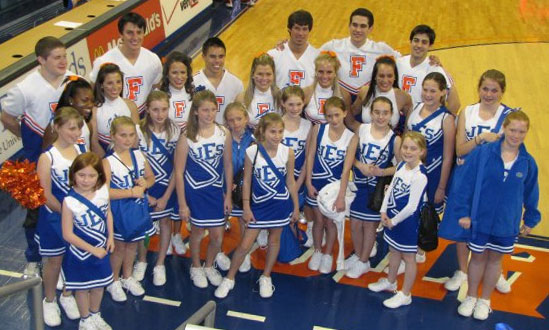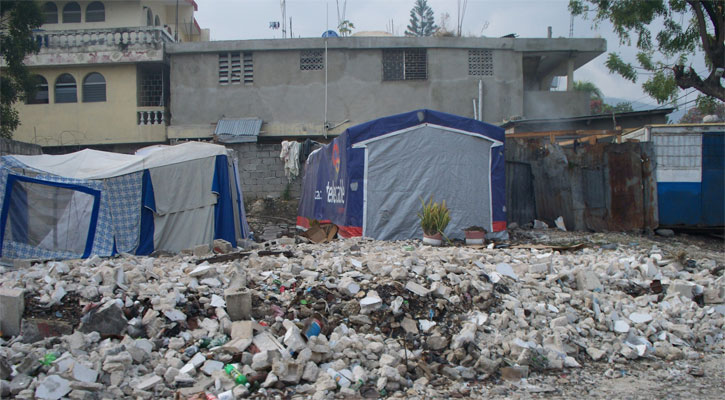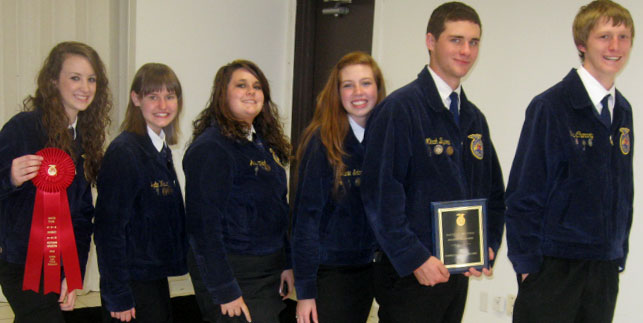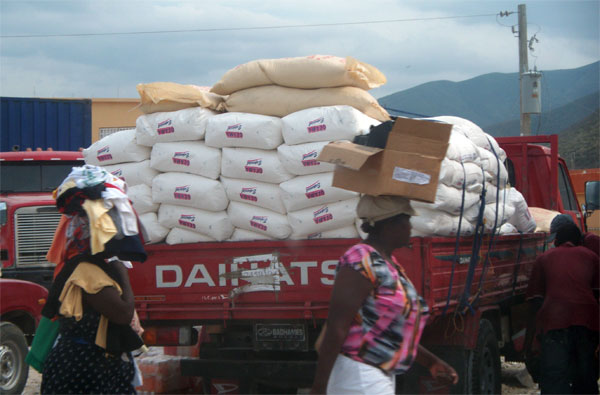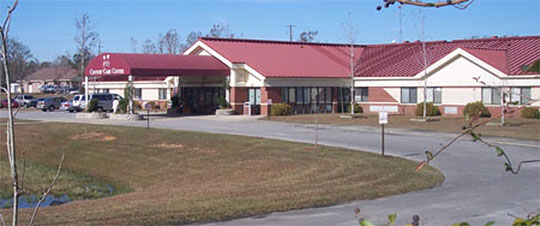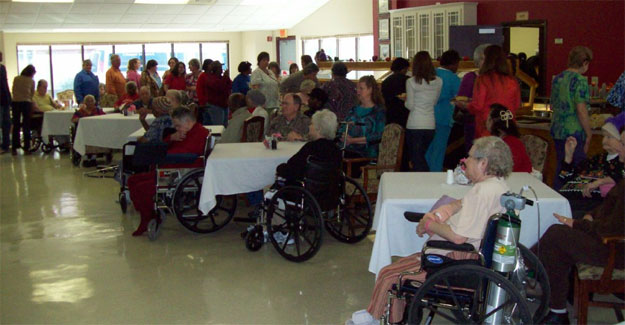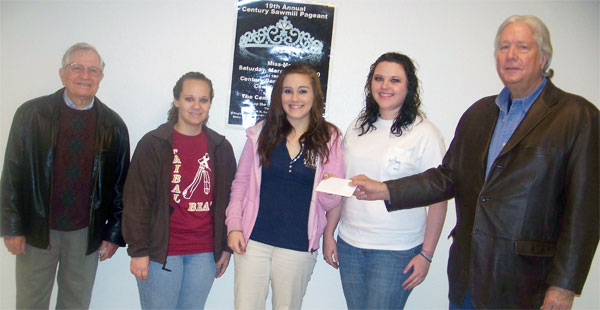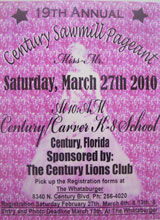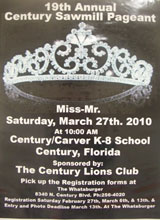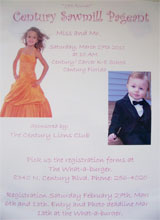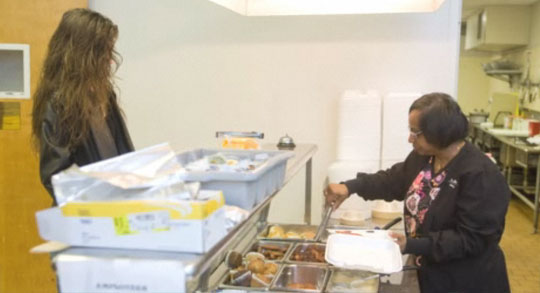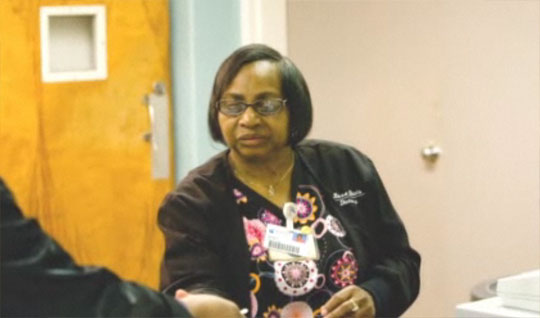Jay Elementary Cheerleaders Cheer For Florida Gators
March 11, 2010
The Jay Elementary Cheerleaders recently had the opportunity to cheer for the Florida Gators. The girls attended a Florida Lady Gators basketball game where they were greeted by the Gator cheerleaders and coach.
Members of the Jay Elementary cheerleaders are Sunny Maher, Courtney Walther, Taylor Scott,Danielle Harrington, Madison Edwards, Connor Andrews, Lexie Nash, Hope Miller, Megan Teevan, Rebecca Boutwell, Robin Green, Savannah Seevers, Courtney Walther, Amber Parker, Maci Holt and Launa Burkhead.
Pictured above: The Jay Elementary cheerleaders with the Florida Gator cheerleaders at a recent Lady Gators basketball game. Submitted photo for NorthEscambia.com, click to enlarge.
Try These Questions From An Actual Fifth Grade FCAT
March 10, 2010
As the FCAT continues in schools across North Escambia, we thought we would help you waste a little time by playing a game of “Are You Smarter Than a Fifth Grader?” with actual questions from past fifth grade FCATs.
Grab everybody around you and get ready. To play along and see how you might do on the fifth grade FCAT, you’ll need a piece of paper to record your answers to the following questions:
(1) Samantha baked a dessert for her class using the recipe shown below.
Samantha used the least amount of which ingredient?
CRANBERRY APPLE CRUNCH
- A. 3/4 cup chopped apples
- B. 1/2 cup oats
- C. 2/3 cup cranberry sauce
- D. 1/4 cup brown sugar
(2) Louie made 17 bag lunches for the school outing. If Louie
had made 4 more lunches, he would have made exactly
3 times as many bag lunches as Marc did. How many lunches did Marc make?
- A. 6
- B. 7
- C. 13
- D. 4
(3) Coach Neal is planning a track meet for 84 students. Each race has 3 teams,
with 4 runners on each team. How many races should Coach Neal plan so
that each student runs in exactly one race?
- A. 7
- B. 12
- C. 21
- D. 28
(4) Toshi wants to find out which after-school sport is most popular among all
the students at his elementary school. Which of these groups would be best
to survey in order to get this information?
- A. all students at the school
- B. all teachers at the school
- C. all fifth grade students at the school
- D. all parents of the students at the school
(5) The 1927 legislative session designated the mockingbird as the state bird of
Florida. The bird is about 10 inches long and has a wingspan of 15 inches.
Which fraction represents the mockingbird’s length compared to
its wingspan?
- A. 1/5
- B. 2/15
- C. 2/3
- D. 3/2
(6) Angie is flying to London, England, on a plane departing at 2:00 p.m. She is
required to be at the airport one and a half hours before the departure time and it takes her 45 minutes to get from her house to the airport. What is the latest time
Angie can leave her house to arrive at the airport at the required time?
- A. 11:45 am
- B. 12:30 am
- C. 1:15 pm
- D. 4:15 pm
(7) Melanie measured the mass of the textbooks in her backpack. Which unit of
measure best describes the mass of the textbooks?
- A. 3 grams
- B. 3 kilograms
- C. 3 metric tons
- D. 3 milligrams
(8) Marchelle built a rectangular wooden picture frame. The frame has a
perimeter of 130 inches and a width of 30 inches.
What is the height, in inches, of the picture frame?
- A. 30 inches
- B. 35 inches
- C. 10 inches
- D. 13 inches
(9) Sonya has to write the greatest four-digit number she can think of by
following these three rules:
1. Any digit 0 through 9 may be used.
2. Any digit may be used only once.
3. There must be an 8 in the tens place.
What is the greatest number Sonya could write by following the three rules?
- A. 9876
- B. 9786
- C. 8796
- D. 9867
For the next two questions, read the two selections in blue.
Betsy Brandon Meets the Betsy Brandon Meets the President
by M.V. Pollock
There was a flurry of excitement in the Brandon household early one morning in
1791. It was the day that General Washington, the president, was supposed to visit
Salisbury, North Carolina. For most of the people, it would be their only chance to
see anyone so important. Everybody planned to be there. Everybody, it seemed,
except fourteen-year-old Betsy, the oldest child of Squire Richard Brandon’s
family. Betsy had to stay at home to finish the chores.
“Ha! Betsy won’t get to see the president,” teased the younger children as they
climbed into the family buggy. Betsy tried to hide her disappointment as they rode
away.
But Betsy was not one to mope. She returned to the kitchen and washed the
breakfast dishes and swept the floor. Then she took her bonnet from the hook on
the back of the door. She was going outside to feed the chickens. But what was
that rumbling noise? It sounded like wheels, but not like those of her father’s
buggy. It seemed to come from the opposite direction.
Betsy hurried to the front door and peeked out. Her eyes grew wide. Coming
down the road that passed in front of the house was the most beautiful coach she
had ever seen. It was pale ivory and trimmed in gold.
As it came near, Betsy felt herself drawn down the pathway to get a better
view. The coach was decorated with elaborate scenes that reminded Betsy of the
four seasons. And it bore an impressive emblem, like a coat of arms.
Suddenly the driver pulled on the reins. “Whoa!” he said loudly. The ornate
harnesses tinkled musically as the four fine horses halted right in front of the gate
where Betsy stood.
Fearful, Betsy wanted to run, but she felt as if her feet were glued to the path.
The door of the coach opened, and a tall, handsome man in uniform stepped down.
He was almost as tall as her father. He tipped his hat and nodded in her direction.
Then another, even more handsome man stepped out. He was white haired and at
least six-feet-four. Surely they were men of importance on their way to Salisbury
to see the president.
“Good morning, miss,” said the white-haired man. His face was stern and
deeply lined, but his blue eyes were warm and friendly.
“Good morning, sir.” Betsy’s voice quavered when she spoke.
“Is your father home?”
“No, sir.”
“Is your mother home?”
As Betsy shook her head, her golden braids moved back and forth. “My family
all went to Salisbury to see the president,” she explained.
“Did you not wish to see the president, too?” The voice was kind.
“Oh yes, sir,” Betsy replied. “I wanted to see the president more than anything,
but I must stay here to do the chores.”
The two men exchanged amused glances. “If you will prepare breakfast for us,
I promise you will see the president before any of the others.”
Thinking that the president would soon pass by on his way to Salisbury, Betsy
hurried into the kitchen. She prepared a delicious breakfast, which the two men
seemed to enjoy.
They thanked her and prepared to leave. Betsy asked, “Sir, when my family
returns, to whom shall I say I served breakfast?”
The white-haired man climbed inside the coach. Leaning out the window he
smiled. “Just tell them you served breakfast to President Washington and his aide,”
he said. And the coach rolled away in clouds of dust.
Washington by Nancy Byrd Turner
He played by the river when he was young,
He raced with rabbits along the hills,
He fished for minnows, and climbed and swung,
And hooted back at the whippoorwills.1
Strong and slender and tall he grew —
And then, one morning, the bugles blew.
Over the hills the summons came,
Over the river’s shining rim.
He said that the bugles called his name,
He knew that his country needed him,
And he answered, “Coming!” and marched away
For many a night and many a day.
Perhaps when the marches were hot and long
He’d think of the river flowing by
Or, camping under the winter sky,
Would hear the whippoorwill’s far-off song.
Boy or soldier, in peace or strife,
He loved America all his life!
(10) Based on the story and the poem, how was Washington’s life as a child
different from Betsy Brandon’s life?
- A. Washington played by the river, but Betsy played at home.
- B. Washington practiced marching, but Betsy prepared tasty meals.
- C. Washington practiced birdcalls, but Betsy listened for passing coaches.
- D. Washington spent his days playing, but Betsy spent her days helping at home.
(11) Which event from the story FIRST prepares the reader for something
unexpected to happen?
- A. Betsy watched the family buggy leave.
- B. The coach stopped in front of the house.
- C. Betsy wondered what the rumbling noise was.
- D. People were excited about seeing an important man.
(12) Read this sentence from the story.
As it came near, Betsy felt herself drawn down the pathway to get a
better view.
In which sentence below does the word view have the same meaning as it
does in “Betsy Brandon Meets the President”?
- A. Direct your view to the second picture on the left.
- B. The report clearly states the writer’s point of view.
- C. The defense lawyer’s speech affected the judge’s view of the situation.
- D. The guests can get a view of the garden by looking out of the window.
(13) The author of the story describes Washington as having a face that is “stern
and deeply lined” and eyes that are “warm and friendly.” What does this lead
the reader to believe?
- A. Washington was always polite to others, even when he was worried.
- B. Washington’s experiences in life had made him tough, but he remained akind person.
- C. Washington was difficult to know because his looks were so different from his personality.
- D. Washington’s hardships as a soldier made him older than he really was, but he continued to serve his country.
(14) Read these lines from the poem “Washington.”
He said that the bugles called his name,
He knew that his country needed him,
The poet includes these lines to show that Washington
- A. heard the sounds of nature.
- B. wanted to travel the country.
- C. played a musical instrument.
- D. felt patriotic toward his country.
(15) Read these lines from the poem “Washington.”
Perhaps when the marches were hot and long
He’d think of the river flowing by
The poet includes these lines to suggest that whenever Washington felt weary
and tired, he would
- A. find shade by a river.
- B. cool himself in a river.
- C. change his travel route to follow a river.
- D. recall a childhood experience about a river.
That concludes our questions from last year’s actual fifth grade FCAT. Now it is time to grade yourself. Click here for the answer key.
Just so you know…we picked the “easier” multiple choice questions. We did not use the math questions, for instance, where you had to draw geometric figures or show and explain your work.
If you’d like to let us know how you did, add a comment at the bottom of the article.
For the entire fifth grade reading FCAT, click here for the test, or click here for the test with answers.
For the entire fifth grade math FCAT, click here for the test, or click here for the test with answers.
Helping Haiti: What You Can Do; Photo Gallery From Haiti
March 8, 2010
 Today we have the final installment of a three-part series “North Escambia: Helping Haiti”. We are taking you to Haiti through the eyes of two area men that just returned from a disaster relief mission. We will hear about their work in Haiti in their own words, and we’ll see the country through their eyes via their photographs. We will also look at how you can be a part of the effort to provide relief in the earthquake ravaged country.
Today we have the final installment of a three-part series “North Escambia: Helping Haiti”. We are taking you to Haiti through the eyes of two area men that just returned from a disaster relief mission. We will hear about their work in Haiti in their own words, and we’ll see the country through their eyes via their photographs. We will also look at how you can be a part of the effort to provide relief in the earthquake ravaged country.
Today, we’ll look at some of the ways you can help Haiti.
Haiti is still in a country in need, and there are many ways you can help. From a text on your cell phone, to a bucket of food, we’ve listed many of the ways to help below.
If you missed the first two installments of this series over the weekend, you can read them be clicking the links below.
- Haiti through the eyes of Drayton Smith, First Baptist Church of Cantonment
- Haiti through the eyes of Sonny Smith, Hillcrest Baptist Church
Also, we have gallery of photos taken by Drayton Smith in Haiti. Click here for the photo gallery.
Now, here are some ways you can help Haiti:
- Buckets of Hope The First Baptist Church of Bratt and the First Baptist Church of Cantonment are collecting food items in the “Buckets of Hope” program. Complete buckets and other donations are due in Bratt by March 14 and in Cantonment by March 15. Click here for more info.
- Health Kits Aldersgate United Methodist Church in Molino is collecting supply donations to assemble “health kits” for Haiti. Click here for more info.
- American Red Cross, 800-733-2767
- Clinton Foundation, 501-748-0471
Text “HAITI” to 20222 to donate $10 - Compassion International www.compassion.com
- Florida Baptist Convention www.flbaptist.org
- Bethany Christian Services – www.bethany.org/donate
-
Action Against Hunger, 877-777-1420
-
Agape Flights, 941-584-8078
-
Airline Ambassadors International, 866-264-3586
-
American Refugee Committee, 800-875-7060
-
Beyond Borders, 866-424-8403
-
Catholic Relief Services, 800-736-3467
-
Childcare Worldwide, 800-553-2328
-
Concern Worldwide, 212-557-8000
-
Doctors Without Borders, 888-392-0392
-
Habitat for Humanity, 1-800-422-4828
-
Lions Club International Foundation, 630-203-3836
-
Mennonite Central Committee, 888-563-4676
-
Mercy Corps, 888-256-1900
-
Samaritan’s Purse, 828-262-1980
-
UNICEF, 800-367-5437
-
United Methodist Committee on Relief, 800-554-8583
Northview FFA Participates In District Competition
March 7, 2010
Northview High School recently participated in the FFA District Competition at the Jay Community Center.
Micah Byars placed first in Exemplary Public Speaking, and Heather Kite placed second in Prepared Public Speaking.
Other participants included:
- AG Mechanics: Micah Byars, Wes Chancery, and Allie Vidak
- AG Business Management: Allie Vidak, Stephanie Solari, Lydia Weaver, and Heather Kite
Pictured top: (L-R) Heather Kite, Lydia Weaver, Allie Vidak, Stephanie Solari, Micah Byars and Wes Chancery. Submitted photo for NorthEscambia.com, click to enlarge.
Helping Haiti Part II: Local Disaster Relief Team Visits Ravaged Country
March 7, 2010
 Today we have the second installment of a three-part series “North Escambia: Helping Haiti”. We are taking you to Haiti through the eyes of two area men that just returned from a disaster relief mission. We will hear about their work in Haiti in their own words, and we’ll see the country through their eyes via their photographs. We will also look at how you can be a part of the effort to provide relief in the earthquake ravaged country.
Today we have the second installment of a three-part series “North Escambia: Helping Haiti”. We are taking you to Haiti through the eyes of two area men that just returned from a disaster relief mission. We will hear about their work in Haiti in their own words, and we’ll see the country through their eyes via their photographs. We will also look at how you can be a part of the effort to provide relief in the earthquake ravaged country.
Today, in his own words, Drayton Smith from the First Baptist Church of Cantonment describes his recent Pensacola Disaster Relief team visit to Haiti. Monday morning, we will learn how you can do you part to help Haiti. The photographs that accompany this article were taken by Smith in Haiti.
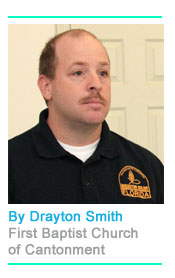 On February 8th I received a call from Florida Disaster Relief wanting a group of four to travel to Haiti for building inspection and Chaplaincy. They wanted us to leave on the 12th. I could not leave that soon so we left on the 17th. At that time no flights were able to go into Port-Au-Prince so we flew into the Dominican Republic. On the 18th we traveled to Haiti by bus. A trip that was about 200 miles would take all day. The roads are inferior to say the least. We left around 4 a.m., as the sun peaks over the mountain range we can see the banana plantations along with the sugar cane fields.
On February 8th I received a call from Florida Disaster Relief wanting a group of four to travel to Haiti for building inspection and Chaplaincy. They wanted us to leave on the 12th. I could not leave that soon so we left on the 17th. At that time no flights were able to go into Port-Au-Prince so we flew into the Dominican Republic. On the 18th we traveled to Haiti by bus. A trip that was about 200 miles would take all day. The roads are inferior to say the least. We left around 4 a.m., as the sun peaks over the mountain range we can see the banana plantations along with the sugar cane fields.
As we approach the border things become very chaotic. It is very crowded and large trucks with supplies are blocking the road way. Our driver goes in to take care of all the paperwork and we are on our way again. The roads continue to be very crowded for quite some time. Check points are set up all along the way. As we get closer to Port au Prince congestion gets worse. We see many military vehicles from all over the world. The streets are filled with people. Some selling fruits and vegetables, others begging for money. All along the edge of the roads we see tents and temporary shelters made from scrap lumber, tin, tarpaulins bearing names like USAID, RED CROSS, and other symbols and emblems. We approach our destination where we will be calling home for the next week. It seems to be in tact. Running off of batteries during the day and a generator to charge the batteries at night. Across the alley we see a home that has collapsed and hear of a 2 year that has lost their life from the falling roof. This hits home with me, I have a two year old.
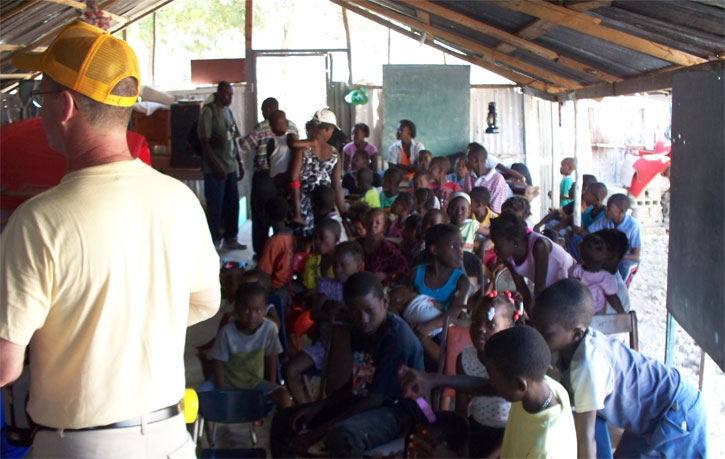 As we get up on our first day we visit with local pastors who welcome us with open arms and somewhat of a smile. We inspect several homes and churches that day. We find out that everyone is petrified to return back into their homes, even if they are safe to go in. “What if it happens again?” That seems to be the question everyone asked. As we pray for those and try to minister to them, we struggle to find the words to say, “its going to be okay.” Its hard because we do not know when and if another quake will happen. Everyone knows someone who lost someone.
As we get up on our first day we visit with local pastors who welcome us with open arms and somewhat of a smile. We inspect several homes and churches that day. We find out that everyone is petrified to return back into their homes, even if they are safe to go in. “What if it happens again?” That seems to be the question everyone asked. As we pray for those and try to minister to them, we struggle to find the words to say, “its going to be okay.” Its hard because we do not know when and if another quake will happen. Everyone knows someone who lost someone.
As the week progresses we meet several new friends from all over the US. They all have come as part of the SBC Disaster Relief. Some are doctors, nurses, pharmacist, others are building inspectors and Chaplains. Each having left their families, jobs and homes to minister to those in need. Over and over I recall the scripture Matthew 22:34-40 “love the Lord and love your neighbor as yourself” (paraphrased). That is what we are doing, Haiti is our neighbor.
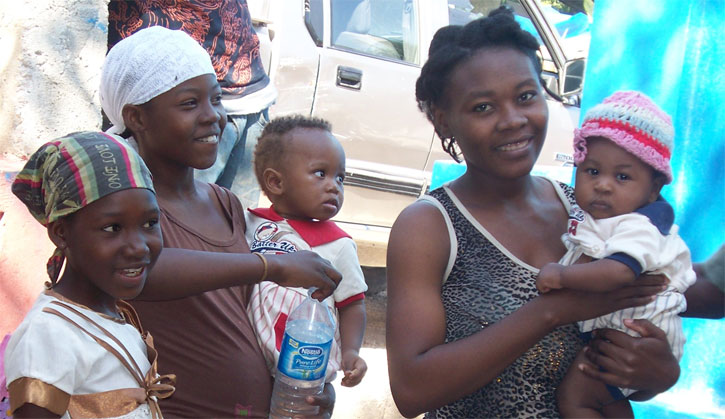 During the week we spend time with parents who have lost children, children who lost parents. We met one lady whose daughter had been kidnapped for seven days before the authorities were able to catch the criminals that took her. We continue to hear the stories of people losing everything. One lady shares of her daughter in nursing school where 300 nurses perished wqhen the roof collapsed. We see where a small hole has been dug out when a 26 year old boy lost his life. I hear from the parent of a nine and three year old who lost their lives. That’s the hard part for me, what to say to these parents.
During the week we spend time with parents who have lost children, children who lost parents. We met one lady whose daughter had been kidnapped for seven days before the authorities were able to catch the criminals that took her. We continue to hear the stories of people losing everything. One lady shares of her daughter in nursing school where 300 nurses perished wqhen the roof collapsed. We see where a small hole has been dug out when a 26 year old boy lost his life. I hear from the parent of a nine and three year old who lost their lives. That’s the hard part for me, what to say to these parents.
There is no equipment at all, men are removing rubble and tearing down buildings with make-shift tools and bare hands. Carrying rocks and busting down walls. It is taking hours and days to do what we could do in just a few minutes in the states with our technology and heavy equipment.
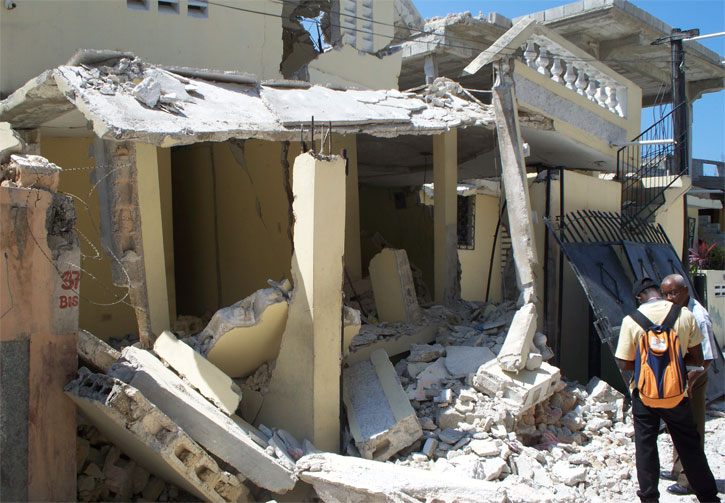 All we can offer is hope, 1 Peter 5:7 states “cast all your anxiety on Him because He cares for you.” And Philippians 4:19 “My God will meet all your needs according to His glorious riches in Christ Jesus.” What can your offer was our question, Jesus was the answer.
All we can offer is hope, 1 Peter 5:7 states “cast all your anxiety on Him because He cares for you.” And Philippians 4:19 “My God will meet all your needs according to His glorious riches in Christ Jesus.” What can your offer was our question, Jesus was the answer.
While we were there we heard chanting from the voodoo and heard the loud speakers of the Satanist wanting the churches torn down. We kept our eyes on Jesus and shared Him when we could. That was the best comfort for them. (2 Corinthians 1:3-11)
During the nights when the aftershock and tremors would wake us up I would remember the scriptures in Psalm 18 and Isaiah 24 where it speaks of the earth shaking. My mindset was to go and help and be a blessing to the people of Haiti, the blessing was for me. I thank God for how He opened my eyes and provided and protected me.
Photos by Drayton Smith, First Baptist Church of Cantonment, for NorthEscambia..com, click to enlarge.
Helping Haiti: Local Disaster Relief Team Visits Part I
March 6, 2010
 Today we begin a three-part series “North Escambia: Helping Haiti”. We will take you to Haiti through the eyes of two area men that just returned from a disaster relief mission. We will hear about their work in Haiti in their own words, and we’ll see the country through their eyes via their photographs. We will also look at how you can be a part of the effort to provide relief in the earthquake ravaged country.
Today we begin a three-part series “North Escambia: Helping Haiti”. We will take you to Haiti through the eyes of two area men that just returned from a disaster relief mission. We will hear about their work in Haiti in their own words, and we’ll see the country through their eyes via their photographs. We will also look at how you can be a part of the effort to provide relief in the earthquake ravaged country.
Today, in his own words, Sonny Davis from Hillcrest Baptist Church describes his recent Pensacola Disaster Relief team visit to Haiti. Sunday morning, we will learn more about the trip from Drayton Smith of the First Baptist Church of Cantonment. The photographs that accompany this article were taken by Smith in Haiti.
 The Pensacola Disaster Relief team consisted of two chaplains and two assessors — Sonny Davis, Doug Dickerson, and Scott Baisden from Hillcrest Baptist and Drayton Smith from First Baptist Church of Cantonment. Because the Port-au-Prince airport was stilled closed to commercial traffic at the time of our departure, we flew from Pensacola to Santa Domingo, Dominican Republic.
The Pensacola Disaster Relief team consisted of two chaplains and two assessors — Sonny Davis, Doug Dickerson, and Scott Baisden from Hillcrest Baptist and Drayton Smith from First Baptist Church of Cantonment. Because the Port-au-Prince airport was stilled closed to commercial traffic at the time of our departure, we flew from Pensacola to Santa Domingo, Dominican Republic.
There, we were met by Doug Roberts, IMB missionary. Doug and his wife were our hosts at the mission house in Santa Domingo. When ground transportation could be arranged, we traveled by bus from Santa Domingo to Port-au-Prince. Accommodations were provided at the FL Mission House, which can hold about 55 people. The Mission House receives power from a generator and has running (although not hot) water. The generator is used to pump water from a well to a large cistern on the roof. Water is then available via gravity for showers and toilets. With that many people staying at the house, the cistern could not hold enough water for everyone to take a shower at once. Those arriving back to the mission house later than others would often have to wait at least an hour to repeat the process of filling the rooftop cistern.
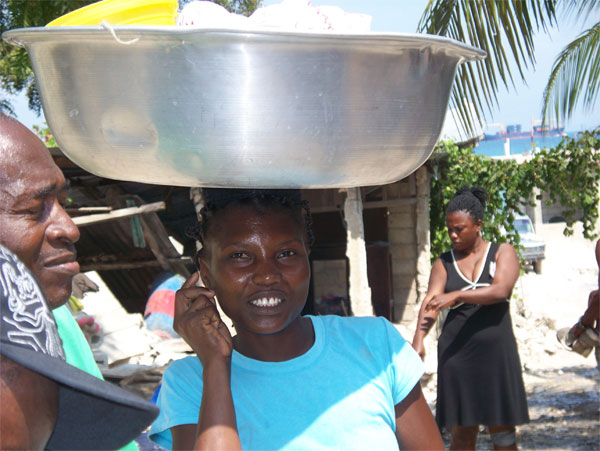 Each morning, our team of four would be assigned to a Haitian pastor, an interpreter, a security person and a driver. Each pastor wanted his church building inspected first, then we would move on to members of his congregation, and further into the community. If the church was determined to be safe, it was then a viable location for a future medical clinic to be staffed by DR medical teams.
Each morning, our team of four would be assigned to a Haitian pastor, an interpreter, a security person and a driver. Each pastor wanted his church building inspected first, then we would move on to members of his congregation, and further into the community. If the church was determined to be safe, it was then a viable location for a future medical clinic to be staffed by DR medical teams.
Maneuvering between houses down narrow lanes was a challenge for even our experienced drivers. Debris littered the streets, and tents were set up in almost any empty space. There are only a few street signs or house markers, so we used portable GPS units to mark the location of each structure that we inspected. Most of the structures that we inspected the first two days were habitable; although almost all needed some sort of repair.
The people have very little money for repairs. For those who did have livable homes, it was more difficult to convince them to sleep inside that it was to do the actual inspection. Each family was pleased that we were there and welcomed the prayers that we offered before moving on to another location. For those of you who have been to third world countries, you are probably familiar with seeing homes constructed primarily of concrete and blocks. No building codes are in effect, and construction materials are inferior; consequently, homes with concrete roofs were more susceptible to destruction than those with tin roofs. There is virtually no glass for windows, almost no running water, and little use of electricity. Many of the homes look like they were built in the 1950s. Some had plumbing fixtures, but they were no longer in use due to the lack of a working water system. Most families had access to a nearby well.
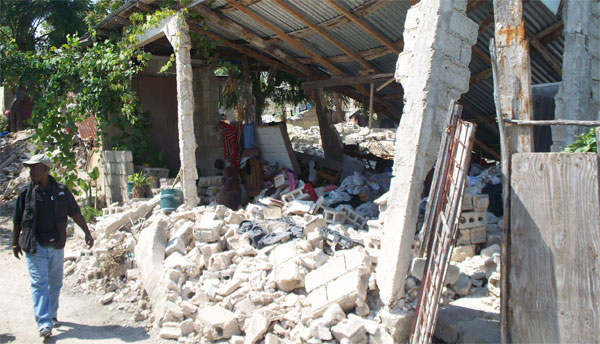 The Haitians buy food and a crude form of charcoal daily and cook on small grills that resemble hibachis. They cook in a small room on the outer edge of the house. Food was being cooked in nearly every home; however, the quantities were always small. Women and girls wear dresses, and men wear long pants. This seems to be a cultural practice, not a religious requirement. The Haitians we visited were clean and had clean clothes, despite having only a kitchen wash pan to bathe and wash their clothes in. None of the families that we visited on the first two days of our adventure had experienced any loss of life in their homes. They all had family members that had been injured or died in the area.
The Haitians buy food and a crude form of charcoal daily and cook on small grills that resemble hibachis. They cook in a small room on the outer edge of the house. Food was being cooked in nearly every home; however, the quantities were always small. Women and girls wear dresses, and men wear long pants. This seems to be a cultural practice, not a religious requirement. The Haitians we visited were clean and had clean clothes, despite having only a kitchen wash pan to bathe and wash their clothes in. None of the families that we visited on the first two days of our adventure had experienced any loss of life in their homes. They all had family members that had been injured or died in the area.
On Sunday, we attended Pastor Joe’s church. His was one of the first churches that we inspected. Even without musical instruments, the church produced a beautiful harmony while singing hymns in Creole. Pastor Joe preached, and an interpreter helped us understand what he said, then Drayton preached and the interpreter helped the congregation understand, and then Pastor Joe preached again. In all, the service lasted almost three hours. Their “pews” were the narrowest, wooden benches that I have sat on. After the service, LA DR volunteers set up a medical clinic and saw close to 300 patients. Most of the patients suffered from respiratory illnesses, high blood pressure, or infections. Many wounds also needed redressing. The people were appreciative and friendly both in the clinic and in the homes we visited. We were surprised by the number of Haitians that spoke some English, but not nearly enough spoke English to allow us to do without the interpreter.
On the last three days of our visit, we traveled with Pastor Pierre for about an hour and a half to the outskirts of Port-au-Prince in the back of a small truck. The truck had been outfitted with wooden benches on both sides of the bed. It also had a raised camper shell with open sides allowing air to flow through, but providing some protection from the elements. Vehicles of this manner are called tap-taps; the Haitian version of a taxi. Our security man always sat on the rear corner of the truck to keep residents from jumping on for a ride. This area had suffered a lot more damage. Very few homes did not suffer significant damage or were totally destroyed. Several families had lost members of their immediate family or close neighbors. It was difficult to tell the people that their home should be torn down.
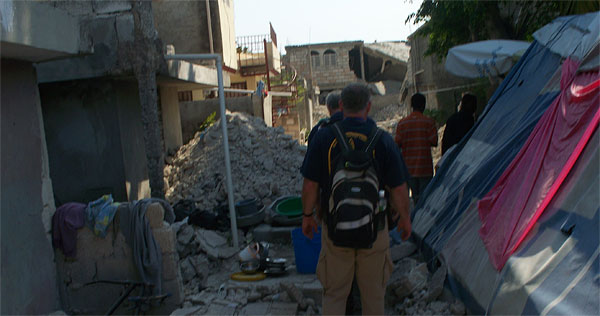 Our job was to inspect and make notes about needed repairs; it was not to make actual repairs. We assured the people that many Christians in the United States were praying for them. We hoped that others would come to help with repairs, although we could not promise that. Often, our prayers were the only hope or comfort we could offer. While inspecting a house in that area, we led five girls and a boy to the Lord, ages 5 – 13. One lady, however, refused to get saved because she said her clothes weren’t good. The pastor promised to go back and visit with her again.
Our job was to inspect and make notes about needed repairs; it was not to make actual repairs. We assured the people that many Christians in the United States were praying for them. We hoped that others would come to help with repairs, although we could not promise that. Often, our prayers were the only hope or comfort we could offer. While inspecting a house in that area, we led five girls and a boy to the Lord, ages 5 – 13. One lady, however, refused to get saved because she said her clothes weren’t good. The pastor promised to go back and visit with her again.
Later that same day while we were inspecting a church, Drayton led sixteen more people to Christ. The next day, seven additional Haitians were saved. Before agreeing to pray, most of the women would find a scarf or handkerchief to cover their heads. Those with bare arms would put on another shirt or wrap a towel around themselves before praying. What a blessing it was to see people eager to come to know Christ. Isn’t it true that tragedy often prods people, no matter where they live, to re-examine their lives? In total, our team inspected 7 churches and over 50 homes. Although the people we visited welcomed us with open arms, Haiti remains a very dangerous country. Our security guard kept a watchful eye on us constantly. He made sure that he stood between us and any possible confrontation. Only women are allowed to stand in line for food. The government is trying to prevent riots by excluding men from food distribution lines.
The Haitian people are very poor; the work to be done is overwhelming; and the Haitians need help to rebuild their lives and their country. Many relief agencies are visible in the country now, but FL Baptists will remain in Haiti long term. The FL Baptists were there for 15 years prior to the earthquake, and they plan to be there indefinitely. Through the efforts of FL Baptists almost 900 churches in Haiti have been established that are now led by Haitian pastors. Since the earthquake 40,000 people have come to know Christ through DR volunteers, Haitian pastors, and a 3-day call to prayer and fasting. The five year vision of the Haitian pastors is for an additional 1.5 million Haitians to come to know Christ. Through your financial help, your prayers, and your time as a volunteer this is possible.
Photos by Drayton Smith, First Baptist Church of Cantonment, for NorthEscambia..com, click to enlarge.
Don’t Be In A Hurry To Fertilize Your Lawn
March 6, 2010
Warmer weather is arriving, but don’t be in a hurry to fertilize your lawn — that’s the word from the University of Florida IFAS Extension office.
Even though it is still winter, now is the time of year that local garden centers begin major advertising campaigns to sell lawn fertilizers. It is too early to fertilize your lawn.
Fertilize when the lawn is actively growing
 Warm-season lawns, including St. Augustinegrass, zoysiagrass, and centipedegrass go dormant in winter in Northwest Florida. Fertilizing now would be a waste of time and money. Why shouldn’t you fertilize warm-season grasses when they are dormant? First, when grasses are dormant, their roots are not able to absorb or use the nutrients from fertilizers. By the time the grass does begin actively growing, most of the nitrogen you applied will have been lost from the soil. A safe time to apply your first lawn fertilizer is around April 15th.
Warm-season lawns, including St. Augustinegrass, zoysiagrass, and centipedegrass go dormant in winter in Northwest Florida. Fertilizing now would be a waste of time and money. Why shouldn’t you fertilize warm-season grasses when they are dormant? First, when grasses are dormant, their roots are not able to absorb or use the nutrients from fertilizers. By the time the grass does begin actively growing, most of the nitrogen you applied will have been lost from the soil. A safe time to apply your first lawn fertilizer is around April 15th.
Don’t feed the weeds
Fertilizing while the grass is dormant actually encourages more winter weeds, because you are fertilizing the weeds instead of the lawn. Without competition from the lawn, these weeds will grow faster and become more prolific as a result of dormant fertilizer applications.
Lastly, fertilizing lawns during their transition into dormancy in the fall or out of dormancy in the spring may encourage lawn growth that is more likely to be injured from winter kill. Bare spots and thinning of the lawn as well as delay in spring green-up may occur when lawns are forced to grow when they should be dormant.
Combo products not the answer
 Many of the products available are convenient “weed and feed” products that combine a pre-emergent herbicide and fertilizer in one application. Unfortunately, the ideal time to apply a pre-emergent herbicide is very different than the ideal time to apply fertilizer for warm-season lawns.
Many of the products available are convenient “weed and feed” products that combine a pre-emergent herbicide and fertilizer in one application. Unfortunately, the ideal time to apply a pre-emergent herbicide is very different than the ideal time to apply fertilizer for warm-season lawns.
In northwest Florida, the recommended application window to maximize the effectiveness of preemergent herbicides is typically between February 15 and March 5.
The application timing for these products is critical since they must be applied before summer annual weeds germinate in spring. It’s always better to apply preemergent herbicides a little earlier rather than too late. And don’t forget to activate them by watering them into the lawn.
For St. Augustine grass, centipede grass, and other warm-season grasses, buy fertilizer that is separate from the pre-emergent herbicide. Apply each at their recommended times.
Finding a separate pre-emergent herbicide, not in weed-n-feed form, may be difficult. Some ones to look for include: benefin (Sta-green Crabgrass Preventer, Hi-Yield Crabgrass Preventer), pendimethalin (Pre-M, Pendulum, Turf Weedgrass Control, Halts Crabgrass Preventer), and bensulide (Green Light Betasan Crabgrass Preventer).
Start with a soil test
A soil test is always a good starting point before investing in fertilizer or lime. Your local University of Florida County Extension office can help you get started.
Theresa Friday is the Residential Horticulture Extension Agent for Santa Rosa County.
Century Care Center Unveils New ‘Person Centered’ Care Model
March 4, 2010
Whether it be at the Teaspoon Cafe or down on Dogwood Lane, there’s a new way of taking care of residents at Century Care Center called the “Person Centered Care Model”.
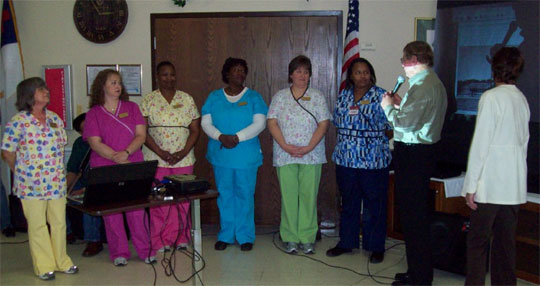 “Our goal is to keep our residents safe, happy, healthy and as active as possible. The Person Centered Care Model gives them more choices, self-respect, independence and keeps them physically and mentally active as possible,” said Don Ripley, Century Care Center administrator.
“Our goal is to keep our residents safe, happy, healthy and as active as possible. The Person Centered Care Model gives them more choices, self-respect, independence and keeps them physically and mentally active as possible,” said Don Ripley, Century Care Center administrator.
Under the Person Centered Care Model, residents are allowed to reasonably keep their lifelong daily rituals. Now, residents get choices like their waking or bedtime, what time they want to eat and their dining preferences.
“They will be asked when they want to take a bath or shower, when they want to get their room cleaned and how they want to decorate their room. People are asked what they want to do each day, activities of their choice that are of interest to them, like going shopping, going for a ride through their old neighborhoods, going to the church of their choice, picnic in the courtyard or by the Ole Mill Pond, doing a little fishing in their own stocked fish pond, card games, painting, music…or any other thing that would help pass the time away.”
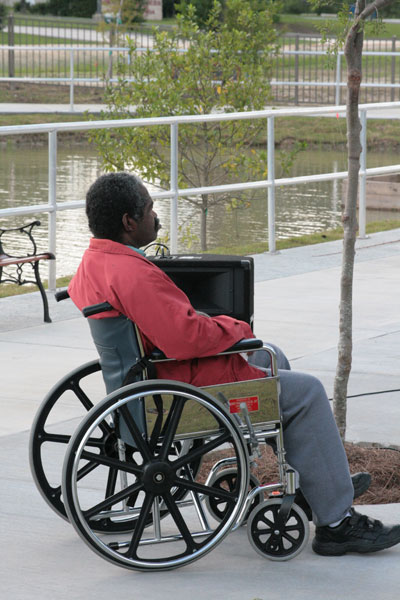 New “communities” and “neighborhoods” have been established within the facility. Hallways and rooms like therapy, dining and showers have been given familiar names from the Century area. Jerry Fischer and Don Sales of the Alger-Sullivan Historic Society assisted Century Care Center in selecting some historic names, such as Spanish Moss Road, Mystic Springs; Dogwood Lane, Country Lane, Teaspoon Cafe, The Spot and Paradise Place.
New “communities” and “neighborhoods” have been established within the facility. Hallways and rooms like therapy, dining and showers have been given familiar names from the Century area. Jerry Fischer and Don Sales of the Alger-Sullivan Historic Society assisted Century Care Center in selecting some historic names, such as Spanish Moss Road, Mystic Springs; Dogwood Lane, Country Lane, Teaspoon Cafe, The Spot and Paradise Place.
The Century Care Center staff has been trained by Eric Haider, CEO and president on Person Centered Care, Inc. and founder of the Person Centered Care Model.
“People who live in long term care communities are not second class citizens. They have worked hard for us. They have fought in the wars and risked their lives to protect our freedoms … let’s not take their freedoms away,” Haider said. “Person Centered Care gives personal attention to the people who live in long term care and empowers staff to be a resident advocate.”
Ripley said the changes “should make Century Care Center the best place to work and will, especially provide our treasured Residents with the happiest and best care, both physically and emotionally, for the rest of their lives”.
Century Care Center was recently named as the Business of the Year by the Century Area Chamber of Commerce The 88-bed facility is ranked by the U.S. Department of Health and Human Services as the number one of 69 nursing homes within 100 miles of Century
Pictured top: Century Care Center. Pictured top inset: The Person Center Care Model is introduced. Pictured bottom inset: A Century Care Center resident enjoying time by the Old Mill Pond. Pictured below: Residents in the “Teaspoon Cafe” at Century Care Center. Submitted and NorthEscambia.com photo, click to enlarge.
NHS Digital Design Students Win Pageant Poster Contest
March 4, 2010
Northview High School’s Digital Design classes participated in a 19th Annual Century Sawmill Pageant poster contest sponsored by the Century Lions Club.
Alissa Fiellin placed first in the contest to create the best poster to promote the pageant. Alex McDonald placed second in the poster contest, and Erin Fremin placed third. Fiellin received a $25 prize for her efforts.
The posters will be used to promote the annual Century Sawmill Beauty Pageant on Saturday, March 27 at 10 a.m. at Carver/Century K-8 School. Registration forms are available at Whataburger in Century.
Pictured: (L-R) Century Lions Club member Edsol Smith, Century Sawmill Pageant Poster Contest winners Erin Fremin, third place; Alissa Fiellin, first place; and Alex McDonald, second place; and Lions member Don Sales. Pictured below: Posters by (L-R) Alex McDonald, Alissa Fiellin and Erin Fremin. Submitted photos for NorthEscambia.com, click to enlarge.
Hospital Employee Named A ‘Legend’ For Helping Others
March 3, 2010
Baptist Health Care has recognized employees who go above and beyond to improve the quality of life for people in the communities served by the organization, including an employee at Atmore Community Hospital.
The health care company recently honored the employees as part of the their “Legends” program.
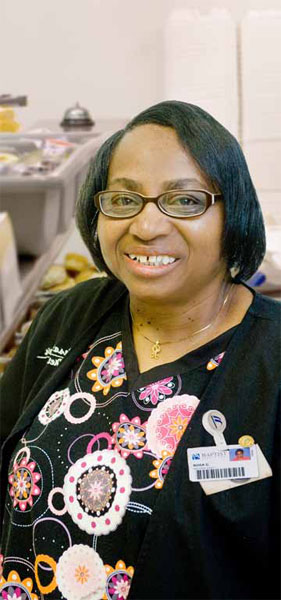 Rosa Davis is a dietary aid and cook in the food services department at Atmore Community Hospital.
Rosa Davis is a dietary aid and cook in the food services department at Atmore Community Hospital.
Davis is a woman of small stature, but has a big heart and strong commitment to helping many people in her community through some challenging situations.
When one neighbor’s home was destroyed by fire, Davis immediately offered her home as a source of shelter. She gathered clothes, food and necessary household items to help comfort and support the family. A few weeks later, one of the family members suddenly became ill. The family did not have the resources to get a much-needed prescription filled, so Davis went to the drug store, purchased the medication and delivered it to the family.
When Davis got news that another neighbor was unable to pay her electric bill, Rosa paid the bill and the power was returned to her neighbor’s home.
Lastly, Davis’ brother had to leave his home when it became flooded with more than a foot of water. Again, Davis was on the scene with food for the family. She arrived with cleaning supplies, too, and went to work putting the house back to order. Davis also serves the community-at-large through local churches.
“Rosa Davis has helped many people in her community through some challenging situations,” said Donna Rogers, director of food services. “Rosa…stands out as a Legend to all of the staff at Atmore Community Hospital.”
Other area Baptist employees nominated for “Legends” status included Stephanie Bain, a nurse manager in the operating room at Jay Hospital and Darren Flott, director of cardiopulmonary services at Atmore Community Hospital.
Pictured: Rosa Davis of Atmore Community Hospital, a Baptist Health Care “Legend”. Courtesy photos for NorthEscambia.com, click to enlarge.


